![]()
![]()
![]()
Use LEFT and RIGHT arrow keys to navigate between flashcards;
Use UP and DOWN arrow keys to flip the card;
H to show hint;
A reads text to speech;
30 Cards in this Set
- Front
- Back
|
X-ray tube external structure |
•support •protective housing -window (port) -leakage (100 mR/hr @ 1meter) cannot excede - oil for insulation and cushions •envelope - Pyrex glass or metal - vacuum- more efficient -gassy/ vaporized tungsten decreases efficiency |
|
|
Cathode |
•negative •filament - coil of wire -thermionic emission -thoriated tungsten- increases efficiency -high melting point (3400°C) -vaporized tungsten (leading cause of tube failure •focusing cup -negative charge - condensed electron beam - made of nickel |
|
|
What is the purpose of the focusing cup? |
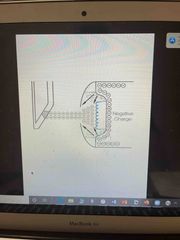
Condenses electron beam together for greater efficiency |
|
|
Space charge effect |
•Cloud of electrons • space charge effect- repulsion of new electrons boiled off (thermionic emission) •saturation current - maximum electron emission |
|
|
Space charge effect |
•Cloud of electrons • space charge effect- repulsion of new electrons boiled off (thermionic emission) •saturation current - maximum electron emission |
|
|
Dual focus |
•small filament - 200 mA or less - better detail •large filament -300 mA or more -large body parts -can withstand more heat |
|
|
Off focus radiation |
•Extrafocal or stem radiation —photons are not produced at the focal spot -tube housing -evaporate tungsten on envelope — can be reduced by entrance shutters or a fixed diaphragm |
|
|
Anode (positive electrode ) |
•Stationary or rotating |
|
|
Rotating anode |
•3400-10,000 RPM • better for heat dissipation •higher tube currents with shorted exposure time. ( more efficient ) • increased heat loading capabilities •target -area of anode that electrons hit (like focal spot) •focal spot - area of target that emits X-rays (interchangeable with target) • 3 layers- tungsten/rhenium, molybdenum, graphite |
|
|
Tungsten |
•high atomic number (#74) -higher efficiency •thermal conductivity - better at heat dissipation •high melting point -3400°C |
|
|
Focal spot |
•where the X-rays are emitted •actual -on target •effective- projected onto patient of image receptor • anode angles of 5-15° -blooming - expanding FSS |
|
|
Line focus principle |
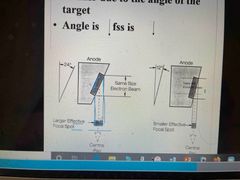
•the effective focal spot with appear smaller due to the angle of the target •if the angle decreased the Effective focal spot is decreased |
|
|
What is larger and which is smaller? Effective focal spot and actual focus spot ? What’s the difference? |
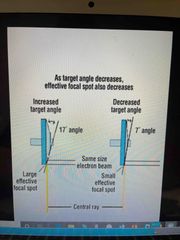
The effective focal spot spot will appear smaller than the actual focal spot due to the angle of the anode. |
|
|
Large Vs. small filament on effective FSS |
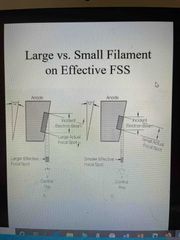
Large focal will have larger effective focal spot than smaller filament. |
|
|
Anode angle and radiation field size |
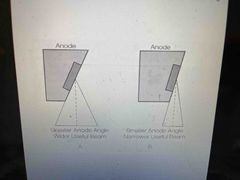
Greater anode angle, wider useful beam. Smaller anode angle, narrower useful beam |
|
|
What happens to the field size as anode angle decreases? |
Radiation Field size (useful beam) decreases |
|
|
Anode heel effect |
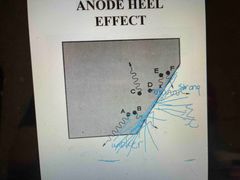
X-rays that travel deeper into target are weaker than those who don’t |
|
|
Anode heel effect summary |
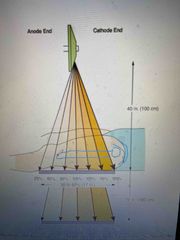
•smaller the anode angle, the larger the heel effect •Radiation intensity on the cathode side is higher than on the anode side • anode angle also affect fields size •Using anode heel effect to our advantage |
|
|
What does the tube envelope do? |
Provides a vacuum so that the Electrons won’t hit air molecules and diverge from their path |
|
|
What Can the leakage radiation not exceed? |
100 mR/ hour |
|
|
What is the purpose of oil around the X-ray tube? |
Cushions and insulates |
|
|
What is the major cause of tube failure? |
Thinning of filament. It evaporates. |
|
|
What material is the focusing cup made of? |
Nickel |
|
|
Causes of tube failure |
•Not following tube rating charts • cracking of anode •not following warm up procedures • excessive heating - increased exposure times - boost and hold (prep) - bearing damage •filament vaporization -most frequent |
|
|
Recommendation for extending tube life |
•warm up machine •do not boost and hold (prep) [minimize usage] •use lower mA stations when possible • use lower speed rotors [less wear and tear, we do not control this] • do not make exposures near tube loading limits • do not move tube too roughly |
|
|
Technique chart |
Gives technologist technical factors in order to produces diagnostic X-ray |
|
|
Tube rating chart |
Determines which radiographic technique is safe or unsafe for tube operation |
|
|
Anode cooling chart |
Determines the time required for a heated anode to cool |
|
|
Housing cooling chart |
Range of 1-1.5 million HU (heat unit) |
|
|
Heat units HU |
•single phase - mA X time X kV •Three phase -mA X time X kV X 1.4 |

